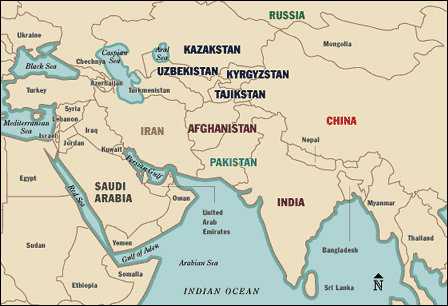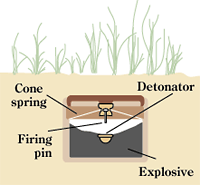


An arid, landlocked
nation now devastated by civil war, earthquakes and drought,
Afghanistan has endured countless invasions by the likes of
Alexander the Great and Genghis Khan. Its ethnically and
linguistically mixed population reflects its position as a
crossroads for historic trade routes through Central Asia. It has
been a pawn in superpower struggles including Imperial Britain and
Russia and most recently been the scene of a Cold War struggle in
which the United States fought a proxy war backing guerrillas who
would evolve into the greatest enemy America has faced in the 21st
century.

 

Afghanistan is extremely poor, highly dependent on farming, sheep
and goats. Military conflict, drought and earthquakes have forced
one-third of the population to flee (as many as 6 million refugees
in Pakistan and Iran). Gross domestic product has fallen
substantially over the past 20 years because of the loss of labor
and capital and the disruption of trade. Economic data is either
unavailable or likely to be unreliable.

Area: 252,000 square miles; slightly smaller than Texas.
Terrain: Landlocked; mostly mountains and desert.
Climate: Dry, with cold winters and hot summers. Kabul's
climate is similar to Denver's, but drier and dustier. Lies between
30 and 40 degrees of latitude — the same as the warm southern
region of the U.S. But an arc of mountains in the north and east
rises as high as 21,000 feet, and the passes between the mountains
seldom see sun in winter.
Time zone: Kabul is 12½ hours ahead of Seattle time.
Key cities: Kabul (political capital); Kandahar (spiritual
capital)
Per capita income: $178 (1999 U.N. estimate), lower than
Bangladesh but higher than Chad.
Foreign aid: Almost totally dependent on international
assistance. U.S. provided about $70 million in 1997, $29 million
this year. The U.N. was also providing significant assistance, but
withdrew because of restrictions imposed by Taliban rulers.
Natural resources: Extensive deposits of coal, natural gas,
salt, chromium, iron ore, gold, fluorite, talc, copper, lapis lazuli
and other gemstones. The remote and rugged terrain and inadequate
transportation make mining unprofitable.
Industries: Small-scale production of textiles, handwoven
carpets, soap, furniture, shoes.
Agricultural products: Opium poppies, wheat, fruit, nuts,
wool, mutton. Only 12 percent of total land area is arable, and less
than 6 percent is cultivated. Irrigation and mechanization
negligible.
Currency: Approx. 6,600 afghanis = $1
Transportation: Landlocked Afghanistan has no railways, but
the Amu Darya (Oxus) River, which forms part of Afghanistan's border
with Uzbekistan and Tajikistan, has barge traffic. Highway
connecting the principal cities needs reconstruction. Ariana
Airlines offers international flights, Bakhtar Airlines internal
flights.

 Since 1999, Afghanistan has produced approximately 75 percent of the
world's opium, putting it ahead of Myanmar (Burma) as the world's
top producer of opium poppies. U.S. officials say the drug trade
brings the Taliban some $50 million a year.
Since 1999, Afghanistan has produced approximately 75 percent of the
world's opium, putting it ahead of Myanmar (Burma) as the world's
top producer of opium poppies. U.S. officials say the drug trade
brings the Taliban some $50 million a year.

Afghanistan has more land mines than any other country. Former
Soviet troops, their mujahedeen guerrilla enemies, and Afghan armies
fighting a civil war laid at least 6 million mines, said Haji
Attiqullah, whose Mine Clearance Planning Agency has mapped
minefields across Afghanistan.
  Antipersonnel
mine (statistics based on Russian data) Antipersonnel
mine (statistics based on Russian data)
Height: 2.2 inches
Diameter: 4.4 inches
Weight: 1.3 pounds
Sensitivity: 18 pounds to 55 pounds of pressure
Sources: State Department; The Washington Post; The Los Angeles
Times; Knight Ridder Newspapers; Gannett News Service; Newhouse News
Services; The Associated Press; Reuters; Times staff research
|